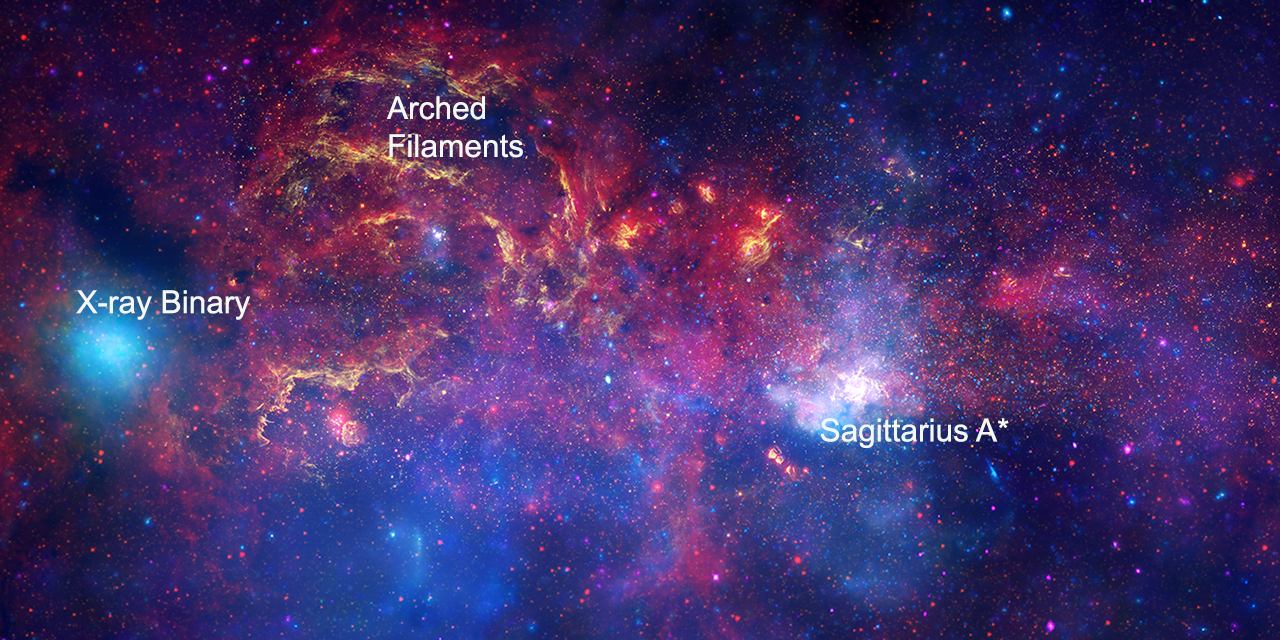
The Universe of Sound data sonification project started out as a way to translate data from NASA’s Chandra X-ray Observatory and other NASA telescopes into sound. Through listening to information about the universe translated into sound, people who are blind or low-vision can also share in those wonders. Working with our partners at SYSTEM Sounds, the project uses mathematical mappings to assign digital sounds to the pixel values of the NASA data (learn more about our sonifications here). A frequent question we get, however, when presenting this sonification work is from musicians who ask if they can play the data.
Our Galactic Center sonification, using data from NASA’s Chandra, Hubble and Spitzer space telescopes, is one of the first pieces we have translated into a composition with sheet music. Working with the composer Sophie Kastner, we have created a soundscape that can now be played by musicians. We hope you enjoy it, and please let us know if you perform this piece with an ensemble.

Where Parallel Lines Converge
Where Parallel Lines Converge is a sonic rendering of a composite image of the Galactic Center, or the center of our Milky Way galaxy, with data from NASA’s Chandra, Hubble and Spitzer space telescopes. The piece is a tryptic, highlighting three astronomical objects or moments in the image: the X-ray binary, the arched filaments, and the supermassive black hole, Sagittarius A*. The piece was conceived using the same principles as the original NASA Chandra data sonifications, converting data to sound by matching different parameters of the image with musical parameters.

I approached the form from a different perspective than the original sonifications: rather than scanning the image horizontally and treating the x-axis as time, I instead focused on small sections of the image creating short vignettes corresponding with these occurrences, approaching the piece as if I was writing a film score to accompany the image. Because the Galactic Center image was so full of information, of material, I wanted to draw the listener’s attention to smaller events within the greater data set.

A composite image of the center of our Milky Way galaxy using data from NASA’s Chandra, Hubble, & Spitzer space telescopes.
New! Download the updated and extended sheet music for the Galactic Center composition, Where Parallel Lines Converge, for chamber ensemble (PDF format) Please let us know if you perform this piece with an ensemble..
Sheet Music
Download the Galactic Center composition’s sheet music for a small ensemble (PDF format). Please let us know if you plan to perform this piece with an ensemble.
Where Parallel Lines Converge, performed by Ensemble Éclat
Based in Montreal, Ensemble Éclat is dedicated to the performance of contemporary classical music and promoting the works of emerging composers. The ensemble seeks to curate unique events by exploiting multimedia elements and mixed music to create captivating programs.
Alex Huyghebaert, flute
Gwénaëlle Ratouit, clarinet and bass clarinet
Charles Chiovato Rambaldo, percussion
Léo Guiollot, percussion
Paul Çelebi, piano
Jeanne Côté, violin
Audréanne Filion, violoncello
Charles-Eric Fontaine, conductor
Seungwoo Han, audio engineer
Priam David, videographer
Video Credit: NASA/CXC/A. Jubett & Priam David
New! Where Parallel Lines Converge was premiered in the U.S. at the Smithsonian's Hirshhorn Museum and Sculpture Garden on November 16, 2024 with the 21st Century Consort as part of the Chandra 25th anniversary campaign. Stay tuned for an international premiere in 2025.
Funded by the Chandra X-ray Center, operated for NASA by the Smithsonian Astrophysical Observatory, under NASA contract NAS8-03060. Project lead: Dr. Kimberly Arcand. Additional support courtesy of McGill University and the ACTOR project (Stephen McAdams, Director), recorded in the Multi Media Room of the Schulich School of Music with the support of CIRMMT
Chandra Listens to the Symphony of Space: Where Parallel Lines Converge
Credits:
Images: X-ray: NASA/CXC/SAO; Optical: NASA/STScI; IR: Spitzer NASA/JPL-Caltech;
Animations: NASA/CXC/SAO/A. Jubett; Univ. of Exeter/Matthew Bate; NASA/ESO/Nick Risinger; Steer & NASA/GSFC;
Edited by: NASA/CXC/SAO/April Jubett;
“Where Parallel Lines Converge”
Sonic rendering of our Milky Way’s center Composed by Sophie Kastner
Title inspired by “Relativity” a Poem by Sarah Howe
Sonification of Galactic Center:
NASA/CXC/Dr. Kim Arcand & SYSTEM Sounds/Dr. Matt Russo & Andrew Santaguida

